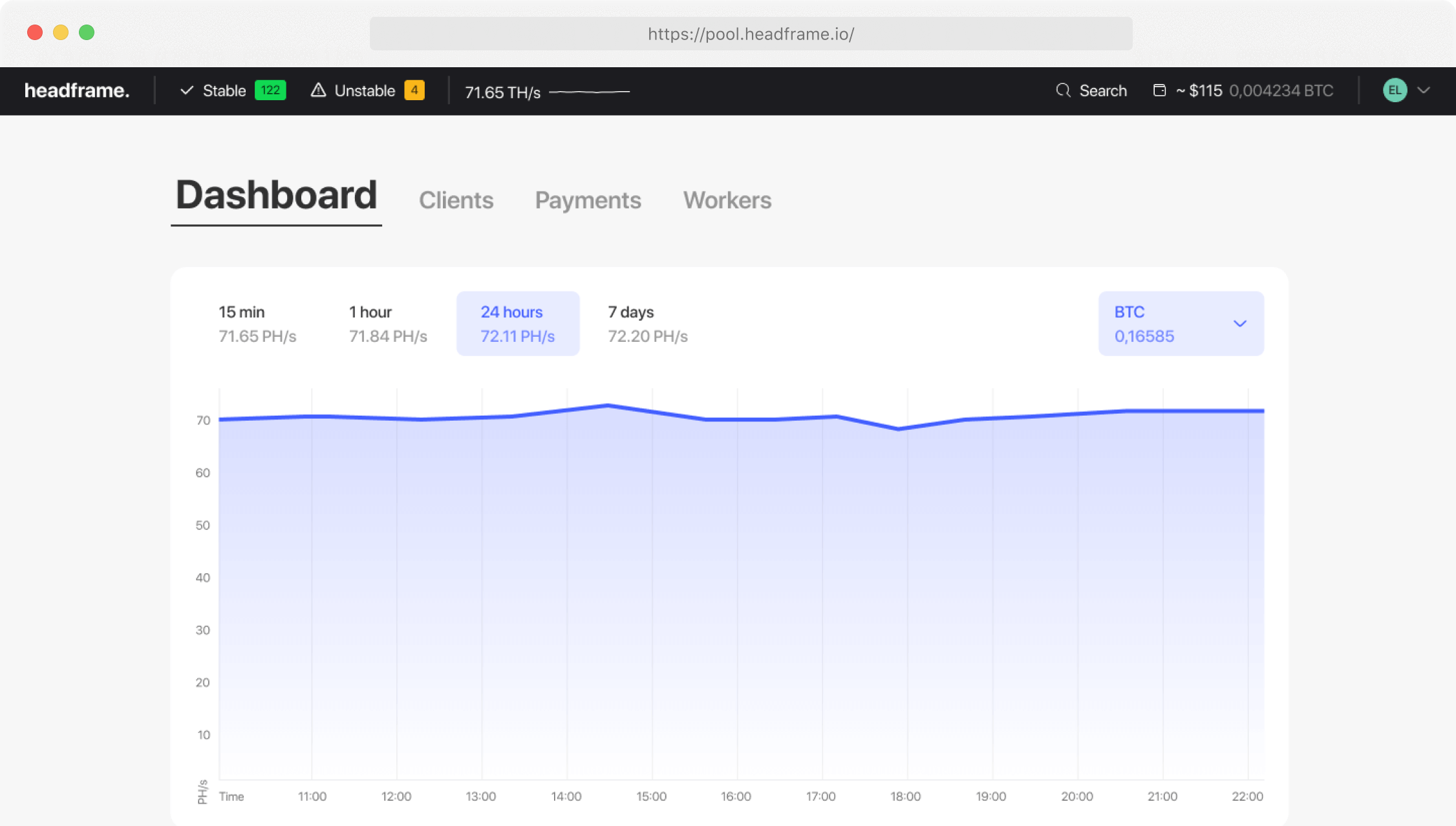
An overview of the different types of asset classes
An overview of the different types of asset classes for investing, including the role of assets in investing, the impact of the economy on assets, the importance of analyzing asset risks, trading indicators, and fraud prevention. Investors should understand the different threats and opportunities to make more informed choices about what to invest in and avoid investment scams and fraud.
Earn more money with Headframe
Join a mining pool and get the best profitability in mining. Already more than 10,000 miners trust Headframe.
- What asset classes are there?
- Evolution of asset classes
- The major asset classes in detail:
- Additional investment categories
- The role of assets in investing
- How the economy affects assets
- The importance of analyzing asset risks
- Investment prudence and fraud prevention
What asset classes are there?
An asset class defines a category of investment instruments that share common financial properties, making their response to market fluctuations similar. Every investor uses these classes to strategically allocate their investments in an effort to optimize risk.
Major asset classes include stocks, bonds, monetary instruments, real estate, commodities, and alternative assets (e.g., hedge funds, private equity, derivatives, cryptocurrencies, art objects).
Evolution of asset classes
The origin and evolution of asset classes is closely linked to the history of human civilization and the financial system. In ancient cultures, physical assets such as precious metals and land were the main value until the advent of the universal medium of exchange, money.
In the Middle Ages, government debt instruments became the predecessors of modern bonds. Later, in the 17th century, through the activities of the Dutch East India Company, equities became a fundamental investment instrument.
In the 20th century, driven by globalization and technological innovation, the world saw a surge of new investment instruments such as derivatives and structured financial products. These changes emphasized the complexity and interconnectedness of the global economy, leading to new risks and opportunities in financial markets.
Loan securitization has become a key element of the financial world, allowing debts to be turned into tradable instruments, freeing up resources for financial institutions and opening the door to new investors. This mechanism has the elegance of an economic technique, but it also carries additional risks, as was seen in the 2008 crisis. This emphasizes the importance of a sound management approach in a complex global economy. The beginning of the 21st century was marked by the emergence of digital assets, with cryptocurrencies at the forefront.
The modern world continues to evolve, with technological and financial innovations driving investment and asset formation trends.
The major asset classes in detail:
Shares
Shares or stocks signify an ownership stake in a company. When you buy them, you become part of the business by investing in its future. Their value can fluctuate due to various reasons such as company performance or the general economic situation. Although shares are a risky instrument, in the long run they can bring significant returns.
Pros:
- Growth Potential: Over the years, stocks have shown better long-term performance than other assets.
- Dividend Income: Many companies pay a portion of their profits to their shareholders in the form of dividends.
- Liquidity: Most stocks are easy to buy and sell in the stock markets.
Cons:
- Volatility: Stock markets are known for their fluctuations, which can create risks and opportunities.
- Risk of loss: If a company suffers losses or faces financial problems, shareholders may lose their investment.
Fixed income
These are instruments through which an investor actually makes a loan to an organization, be it a corporation or the government. In return, he or she receives regular interest payments, making this category more reliable relative to other investment forms.
Pros:
Regular income: Holders of these securities receive regular interest payments, which provides predictable income.
Capital protection: Bonds tend to be a less risky instrument as they promise a return of the invested amount at the end of their term.
Cons:
Rate risk: If rates rise, the market value of bonds can fall.
Inflation risk: The steady income from bonds may not take into account increases in inflation, which affects the real value of your money.
Liquid assets
Liquid assets are assets that can be converted into cash quickly and without significant losses. Examples of such assets include cash, bank deposits and short-term financial instruments. While they may provide less income, they also pose the least risk.
Pros:
Reliability: Because of their liquidity, these assets are considered the least risky.
Flexibility: Liquid assets are easily and quickly exchanged for cash.
Minuses:
Limited returns: Compared to other investment instruments, liquid assets may offer less attractive returns.
Inflation effect: Over time, inflation can “eat away” at the real value of your liquid assets.
Additional investment categories
In addition to the previously mentioned assets, alternative assets include real estate, private equity, hedge funds, venture capital, digital currencies, art objects, collectibles and financial instruments. These assets can enhance portfolio diversification and potentially increase returns, but they most often present greater risk, weaker liquidity and require more investment than classic assets.
Sophisticated investors with a willingness to accept risk are more likely to choose them for investment. Let’s take a closer look at areas such as cryptocurrencies, non-fungible tokens (NFTs) and tokenized assets.
Digital currencies
In addition to traditional investment instruments, cryptocurrencies, such as Bitcoin, are becoming increasingly popular among investors. If you are going to invest in this segment, remember that there are many options available. And while such investments can yield high returns, they are also considered high-risk.
Innovative assets: NFTs and token assets
When encountering innovations in the financial world, you’ll notice NFTs and tokenized assets. These digital resources are overturning perceptions of ownership and value.
NFTs – unique tokens based on blockchain technology – provide the ability to buy and sell everything from digital art to virtual land parcels. Tokenized assets, in turn, move real-world assets onto the blockchain, whether real estate, art objects or corporate stocks.
Such assets provide unique liquidity and accessibility, changing the familiar framework of investing. But they also bring new risks and raise regulatory questions. It is therefore important for professionals to keep abreast of the latest trends in this dynamic area.
Overall, working with NFTs and tokenized assets opens up a new horizon of investing, where the digital and the real mix, offering unprecedented perspectives.
The role of assets in investing
Assets play a key role in investing. Each asset class has unique risks and income opportunities. These values change in response to the global economy and market changes. Investors betting on asset diversity can reduce potential losses and increase the chances of returns.
Understanding different assets helps investors form a strategy that fits their financial goals, future plans and risk preferences.
How the economy affects assets
In the financial world, it’s clear that world events greatly affect asset values. Everything from changes in economic policy to global crises can affect asset values.
For example, when interest rates rise, bond prices may fall. And stocks can react differently to the same events depending on the state of the company or market sector. In times of instability, many investors prefer “safer” assets, such as precious metals or government bonds. At the same time, during favorable periods of growth, risky assets such as equities or digital currencies become more attractive.
It is important for investors to be aware of how world events affect different assets in order to manage their investments as effectively as possible, achieving goals and minimizing risk.
Importance of analyzing asset risks
Analyzing the risks associated with different assets is the foundation of informed investing. Investors, by understanding the various threats and opportunities, can make more informed choices about what to invest in. Various indicators such as volatility, beta coefficient and standard deviation are used to assess risks.
Volatility shows how much an asset’s price can change, providing investors with an indication of possible risks. The beta coefficient measures how an asset reacts to market fluctuations, allowing us to understand its relative volatility. Standard deviation, on the other hand, provides insight into the extent to which an asset’s price deviates from its average, serving as an additional measure of risk.
Profit indicators are of great importance for investors. The main ones are annualized return and compound annual growth rate (CAGR).
The annualized return shows the average annual return, taking into account the effect of compound interest, which makes it easier to compare a variety of investments. CAGR measures the growth rate of an investment over a specific time horizon, taking into account reinvestment of earnings. This indicator helps evaluate how assets grow over time.
Trading indicators such as transaction volumes, the difference between buy and sell rates, and market depth provide information about market dynamics and liquidity. Volumes show how many shares or contracts have been traded over time, providing insight into market activity.
The difference between the bid and ask rates shows the difference between the price at which buyers are willing to purchase an asset and the price at which sellers are willing to sell it. A narrow difference indicates high liquidity. Market depth reflects the market’s ability to absorb large orders without significantly affecting asset values.
Investment due diligence and fraud prevention
Investors must be vigilant to avoid investment scams and fraud, which can lead to significant losses. There are many fraud methods such as Ponzi schemes, pyramid schemes and others. Investors are advised to take certain steps to ensure protection.
Understanding the proposed investment is extremely important. Investors should scrutinize the characteristics of the investment offering, its business structure and potential. Such analysis can help identify potential red flags.
Checking the reputation and documentation of the investment platform or issuer is also critical. It is important to make sure that the necessary licenses are in place and that legislation is being complied with. Investigating the background of the company and its key individuals can help identify past misconduct.
Evaluating historical data and past performance is also important. Analyzing an asset’s past performance, such as returns and stability, can provide insight into its reliability.
By following these guidelines, investors can reduce their risk and ensure that their investments are directed to legitimate and vetted properties.
Source: https://cointelegraph.com/learn/overview-of-different-types-of-asset-classes


